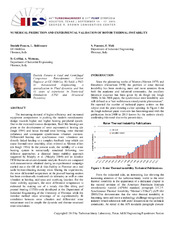| dc.contributor.other | Turbomachinery Symposium (44th : 2015) | |
| dc.creator | Panara, Daniele | |
| dc.creator | Baldassarre, Leonardo | |
| dc.creator | Griffin, Duccio | |
| dc.creator | Mattana, Alessandro | |
| dc.creator | Panconi, Simone | |
| dc.creator | Meli, Enrico | |
| dc.date.accessioned | 2017-09-09T14:06:11Z | |
| dc.date.available | 2017-09-09T14:06:11Z | |
| dc.date.issued | 2015 | |
| dc.identifier.uri | https://hdl.handle.net/1969.1/162126 | |
| dc.description | Lecture | en |
| dc.description.abstract | The increasing demand of higher efficiency and increased equipment compactness is pushing the modern rotordynamic design towards higher and higher bearing peripheral speeds. Due to the increased viscous dissipation, fluid film bearings are prone to the development of rotor asymmetrical heating (de Jongh 1994) and hence thermal rotor bowing, rotor thermal imbalance and consequent synchronous vibration increase. Differential heating and synchronous rotor vibrations are directly linked leading to a complex feedback loop which can cause thermal rotor instability often referred as Morton effect (de Jongh 1994). In the present work, the stability of a rotor bearing system is numerically simulated following two different approaches: a classical linear stability approach suggested by Murphy et al. (Murphy 2009) and an iterative FEM thermo-structural-dynamic analysis. Results are compared with measurements obtained during an experimental campaign carried out at the GE oil & Gas facility in Florence on a real scale between-bearing dummy rotor. During the experiments, the rotor differential temperature at the journal bearing section has been continuously monitored via telemetry as well as rotor vibration at bearing, mid span and overhung location. For the linear stability approach, the rotor differential temperature is estimated by making use of a steady thin-film tilting pad journal bearing (TPJB) code developed at the Department of Industrial Engineering of the University of Florence while the iterative method takes advantage of an experimentally fit correlation between rotor vibration and differential rotor temperature used to couple the dynamic and thermo-structural rotor simulations. | en |
| dc.format.medium | Electronic | en |
| dc.format.mimetype | application/pdf | |
| dc.language.iso | en | |
| dc.publisher | Turbomachinery Laboratories, Texas A&M Engineering Experiment Station | |
| dc.relation.ispartof | Proceedings of the 44th Turbomachinery Symposium | en |
| dc.subject.lcsh | Turbomachines | en |
| dc.title | Numerical Prediction And Experimental Validation Of Rotor Thermal Instability | en |
| dc.type.genre | Presentation | en |
| dc.type.material | Text | en |
| dc.format.digitalOrigin | born digital | en |
| dc.identifier.doi | https://doi.org/10.21423/R1ND09 | |


